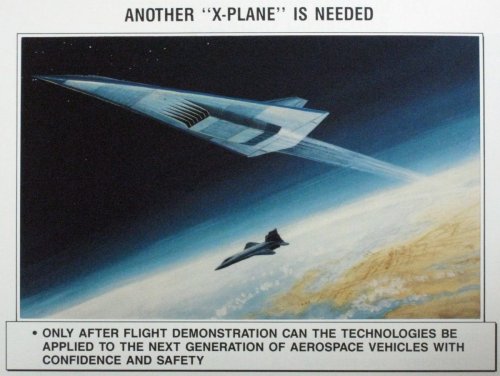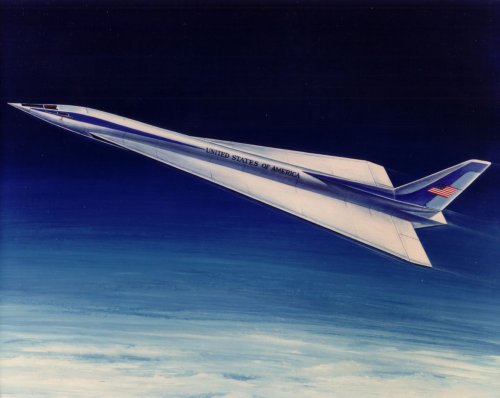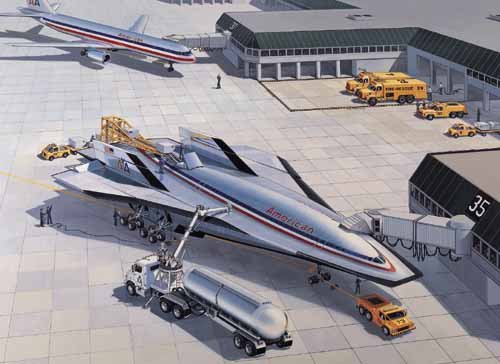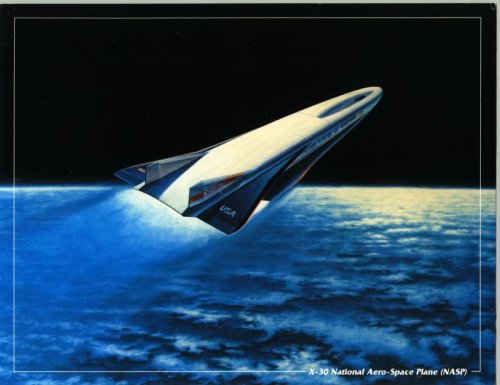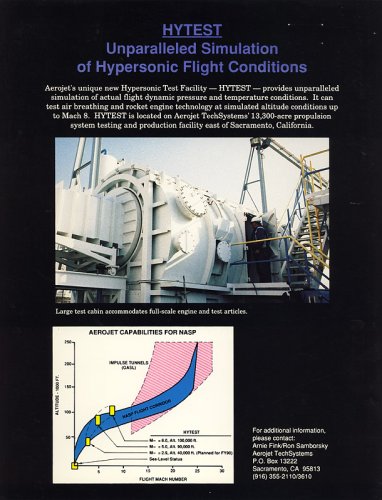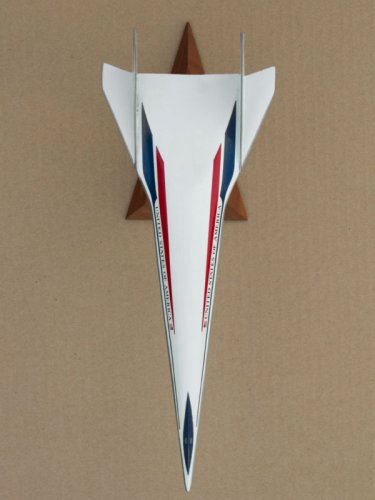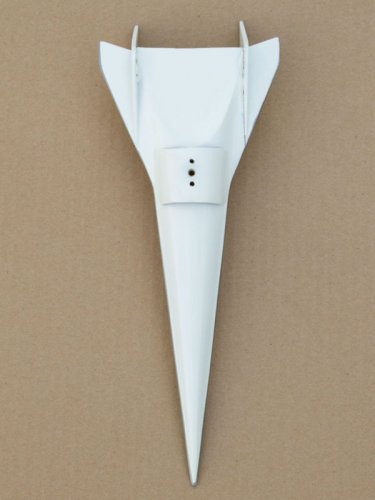You are using an out of date browser. It may not display this or other websites correctly.
You should upgrade or use an alternative browser.
You should upgrade or use an alternative browser.
National Aero-Space Plane - NASP - X-30
- Thread starter flateric
- Start date
- Joined
- 6 August 2007
- Messages
- 3,894
- Reaction score
- 5,972
sferrin said:exactly what was NASP's propulsion system to take it from 0 to Mach 7 suppose to be? ???
For a long time, classified.
If I remember correctly, it was an ejector ramjet
shockonlip
ACCESS: Top Secret
- Joined
- 29 January 2008
- Messages
- 605
- Reaction score
- 57
If you read T.A. Heppenheimer's "Facing The Heat Barrier: A History of Hypersonics",
he indicates that the X-30 was to use for its Low Speed System (LSS), the
Special System, an ejector ramjet and the Low Speed Oxidizer System, which used
LACE. (Footnote 28: 1989 NASP Technical Maturation Plan, task 2.1.02; Air Power History,
Fall 2000, diagram, p. 26; DTIC ADB-191715, p. ES-4; ADB-968993, p. 24.)
They didn't have it working by the time the program ran out of money, so
were going to use a rocket instead, and then come back to LACE later.
Read the story starting on pg. 239 (top) to pg 244, ending at "Materials"
(these are the page nos. on the bottoms of the actual pages).
This book is available for download from NASA:
http://history.nasa.gov/sp4232-part1.pdf
http://history.nasa.gov/sp4232-part2.pdf
http://history.nasa.gov/sp4232-part3.pdf
Pretty Interesting!
he indicates that the X-30 was to use for its Low Speed System (LSS), the
Special System, an ejector ramjet and the Low Speed Oxidizer System, which used
LACE. (Footnote 28: 1989 NASP Technical Maturation Plan, task 2.1.02; Air Power History,
Fall 2000, diagram, p. 26; DTIC ADB-191715, p. ES-4; ADB-968993, p. 24.)
They didn't have it working by the time the program ran out of money, so
were going to use a rocket instead, and then come back to LACE later.
Read the story starting on pg. 239 (top) to pg 244, ending at "Materials"
(these are the page nos. on the bottoms of the actual pages).
This book is available for download from NASA:
http://history.nasa.gov/sp4232-part1.pdf
http://history.nasa.gov/sp4232-part2.pdf
http://history.nasa.gov/sp4232-part3.pdf
Pretty Interesting!
- Joined
- 6 August 2007
- Messages
- 3,894
- Reaction score
- 5,972
shockonlip said:Pretty Interesting!
Pretty loud either way!
shockonlip
ACCESS: Top Secret
- Joined
- 29 January 2008
- Messages
- 605
- Reaction score
- 57
Yes Dan, definitely loud.
You're right, an ejector.
I think we're going to hear more about cryo-cooling however.
You can get a nice pressure ratio!
You're right, an ejector.
I think we're going to hear more about cryo-cooling however.
You can get a nice pressure ratio!
- Joined
- 6 August 2007
- Messages
- 3,894
- Reaction score
- 5,972
shockonlip said:Yes Dan, definitely loud.
You're right, an ejector.
I think we're going to hear more about cryo-cooling however.
You can get a nice pressure ratio!
I'd forgotten about the LACE aspect of it. Around the same time, Rockwell was looking at LACE and related things. A good amount of their own money was spent on it, which was surprising considering how difficult it can be to get working.
MIPPC seemed very promising before it "disappeared"
Tuomasn
ACCESS: Secret
- Joined
- 5 January 2006
- Messages
- 477
- Reaction score
- 358
Does anyone have a three-view drawing of the "duPont Government Baseline" vehicle? Also any dimensional info besides the TOGW of 50,000 pounds? I've been thinking for some time of making a 3D model of this design to go along my 3D Tu-2000A that shares a very similar configuration. Would make for an interesting comparison; also perhaps eventually have it flyable in the Orbiter simulator.
Image from The Hypersonic Revolution. Case Studies in the History of Hypersonic Technology. Vol.3 referenced above.
Image from The Hypersonic Revolution. Case Studies in the History of Hypersonic Technology. Vol.3 referenced above.
Attachments
archipeppe
ACCESS: Top Secret
- Joined
- 18 October 2007
- Messages
- 2,431
- Reaction score
- 3,152
Meteorit said:Does anyone have a three-view drawing of the "duPont Government Baseline" vehicle? Also any dimensional info besides the TOGW of 50,000 pounds? I've been thinking for some time of making a 3D model of this design to go along my 3D Tu-2000A that shares a very similar configuration. Would make for an interesting comparison; also perhaps eventually have it flyable in the Orbiter simulator.
Image from The Hypersonic Revolution. Case Studies in the History of Hypersonic Technology. Vol.3 referenced above.
If someone has that 3 views, even very rough, I will restitute it in full-colour drawing.
Tuomasn
ACCESS: Secret
- Joined
- 5 January 2006
- Messages
- 477
- Reaction score
- 358
Some NASP videos found at Youtube:
For those who thought Star Wars was too realistic: duPont baseline first deploys a satellite from a sizeable payload bay and then takes some passengers to a space station. Also has a lovely NASP scale model (I want one! ;D).
http://www.youtube.com/watch?v=TMyX63E2cyU
http://www.youtube.com/watch?v=BnOrc4KnaII
At least this one has sufficient amount of "if"s, "may"s and "might"s. Gotta admire that heatproof strobelight on the X-30's bottom. Contains some shots of X-30 simulator cockpit.
http://www.youtube.com/watch?v=BPkKbNWAc90
For those who thought Star Wars was too realistic: duPont baseline first deploys a satellite from a sizeable payload bay and then takes some passengers to a space station. Also has a lovely NASP scale model (I want one! ;D).
http://www.youtube.com/watch?v=TMyX63E2cyU
http://www.youtube.com/watch?v=BnOrc4KnaII
At least this one has sufficient amount of "if"s, "may"s and "might"s. Gotta admire that heatproof strobelight on the X-30's bottom. Contains some shots of X-30 simulator cockpit.
http://www.youtube.com/watch?v=BPkKbNWAc90
Meteorit said:For those who thought Star Wars was too realistic: duPont baseline first deploys a satellite from a sizeable payload bay and then takes some passengers to a space station.
Wow. Now that's some impressively low-rez computer animation...
Also has a lovely NASP scale model (I want one! ;D).
I've got that one. Actually, it's the only official desktop model I have that's display-worthy. Been contemplating recasting it.
Here is an image from I believe popular mechanics showing an American Airline version of the NASP (can anyone find out which exact issue that was?) And below that is a model I used to have of the Orient Express.
Lastly I want to know if anyone here has any old issues of air and space magazine. The Aug/Sept 1986 issue had on the cover a really neat illustration of the NASP, along with more pictures and an article on the inside. I can never find this issue on ebay or anywhere else. Matter of fact if anyone here knows good online stores to buy old magazines I would most appreciate it.
Lastly I want to know if anyone here has any old issues of air and space magazine. The Aug/Sept 1986 issue had on the cover a really neat illustration of the NASP, along with more pictures and an article on the inside. I can never find this issue on ebay or anywhere else. Matter of fact if anyone here knows good online stores to buy old magazines I would most appreciate it.
Attachments
Robert McCall paintings (From his official website)
notice the first one seems based on the Boeing design and the last 2 look like the Rockwell design
notice the first one seems based on the Boeing design and the last 2 look like the Rockwell design
Attachments
- Joined
- 13 June 2007
- Messages
- 2,173
- Reaction score
- 3,093
Greetings All -
A nice looking model of a concept for the X-30 NASP:
http://cgi.ebay.com/TOPPING-PENWAL-X-30-NASP-OLD-CONCEPT-SPACE-MODEL-EXLNT-/200508723226?pt=LH_DefaultDomain_0
Enjoy the Day! Mark
A nice looking model of a concept for the X-30 NASP:
http://cgi.ebay.com/TOPPING-PENWAL-X-30-NASP-OLD-CONCEPT-SPACE-MODEL-EXLNT-/200508723226?pt=LH_DefaultDomain_0
Enjoy the Day! Mark
Penwal X-30 concept model
I bought several X-30 concepts from a Pratt & Whitney engineer and this is a duplicate. As a part of a five-company team, Pratt & Whitney pursued propulsion technologies for the National Aerospace Plane (NASP); the prototype aircraft was designated X-30. This model was made sometime in the 1980’s by Penwal, one of the companies founded by Topping Models alumni (Walt Hyatt with Jerry Pennington) after Topping’s closing in 1965. It is in excellent shape, with the tiniest bit of yellowing that should clean up nicely with Novus #2 cleaner/polish (although I would just leave it). But there are no chips, breaks, dings, scrapes, flakes, or any other flaws anywhere. Never broken, never repaired--it’s in excellent condition. The fuselage is just over 16” long and the wingspan is 4 inches. The model is made of a solid, heavy and hard injection-molded material and is exceptionally well finished. There are red and blue markings running the length of the fuselage and up the vertical stabilizer. The cockpit windows are gray, the nose is black. Small American flags mark the left wing and each side of the stabilizer. The words “United States of America” run along both sides of the fuselage. The model sits firmly on the stand via two deep pins but is easily removed. The like-new base is a richly finished custom wood faceted triangle with black Plexiglas upright. There is a small Pratt & Whitney eagle logo on it, and a gold nameplate with “X-30 National Aerospace Plane” printed in black. Underneath is a mint label bearing Penwal’s name, logo, and Chino address.The three original protective felt dots are like new. Model will be fastidiously packed with insurance and tracking included.
Attachments
-
 !B0Ymvv!B2k~$(KGrHqZ,!hgEw5,RUeYJBM,GQyrbO!~~_3.jpg54 KB · Views: 128
!B0Ymvv!B2k~$(KGrHqZ,!hgEw5,RUeYJBM,GQyrbO!~~_3.jpg54 KB · Views: 128 -
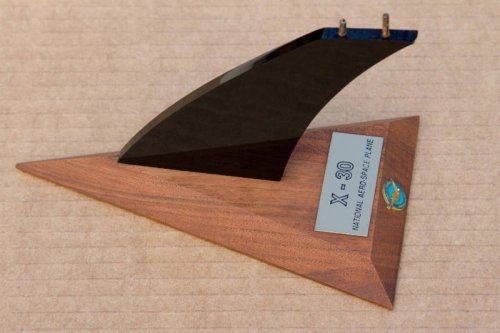 !B0YmvNwBmk~$(KGrHqF,!jEEw5bWkgO0BM,GQwfVC!~~_3.jpg48.2 KB · Views: 100
!B0YmvNwBmk~$(KGrHqF,!jEEw5bWkgO0BM,GQwfVC!~~_3.jpg48.2 KB · Views: 100 -
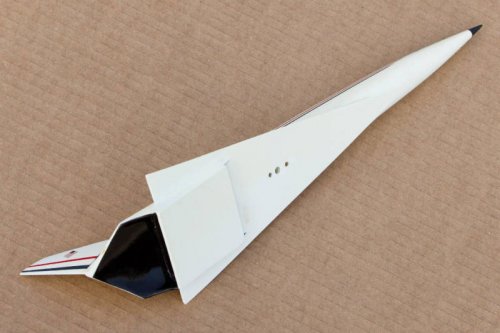 !B0Ymup!BGk~$(KGrHqJ,!iQEw5Ife3huBM,GQuN,qw~~_3.jpg45.7 KB · Views: 107
!B0Ymup!BGk~$(KGrHqJ,!iQEw5Ife3huBM,GQuN,qw~~_3.jpg45.7 KB · Views: 107 -
 !B0YmuMg!Wk~$(KGrHqV,!h8Ew5GsnS3dBM,GQsGotQ~~_3.jpg47.1 KB · Views: 114
!B0YmuMg!Wk~$(KGrHqV,!h8Ew5GsnS3dBM,GQsGotQ~~_3.jpg47.1 KB · Views: 114 -
 !B0Ymtk!Bmk~$(KGrHqN,!g0Ew5CUKk7SBM,GQplGfw~~_3.jpg43.3 KB · Views: 123
!B0Ymtk!Bmk~$(KGrHqN,!g0Ew5CUKk7SBM,GQplGfw~~_3.jpg43.3 KB · Views: 123 -
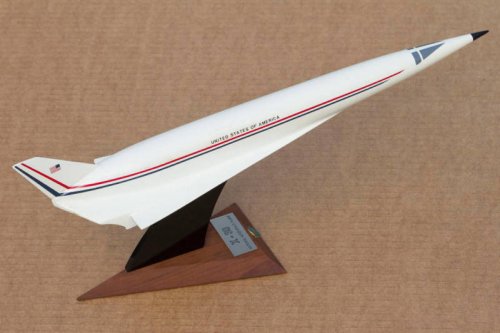 !B0YmtIQEGk~$(KGrHqN,!hMEw5FOsQF9BM,GQn00HQ~~_3.jpg44.4 KB · Views: 138
!B0YmtIQEGk~$(KGrHqN,!hMEw5FOsQF9BM,GQn00HQ~~_3.jpg44.4 KB · Views: 138
- Joined
- 13 June 2007
- Messages
- 2,173
- Reaction score
- 3,093
Thanks Triton! Mark
Mark Nankivil said:Thanks Triton! Mark
You're welcome.
Some additional NASP art:
Attachments
-
 PW_NASP_Investment_booklet_back_800.jpg51.8 KB · Views: 133
PW_NASP_Investment_booklet_back_800.jpg51.8 KB · Views: 133 -
 PW_NASP_Investment_booklet_p6_800.jpg191.4 KB · Views: 137
PW_NASP_Investment_booklet_p6_800.jpg191.4 KB · Views: 137 -
 PW_NASP_Investment_booklet_p5_800.jpg131.7 KB · Views: 124
PW_NASP_Investment_booklet_p5_800.jpg131.7 KB · Views: 124 -
 PW_NASP_Investment_booklet_p4_800.jpg184.1 KB · Views: 111
PW_NASP_Investment_booklet_p4_800.jpg184.1 KB · Views: 111 -
 PW_NASP_Investment_booklet_p3_800.jpg189 KB · Views: 109
PW_NASP_Investment_booklet_p3_800.jpg189 KB · Views: 109 -
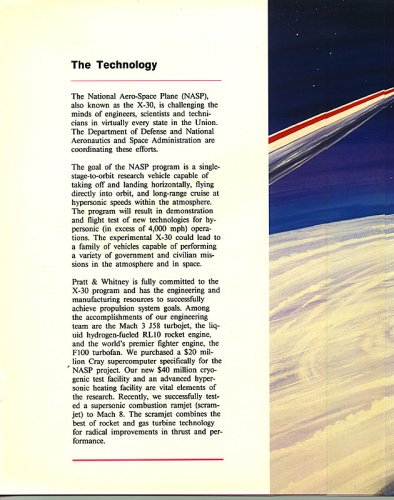 PW_NASP_Investment_booklet_p2_800.jpg203.7 KB · Views: 107
PW_NASP_Investment_booklet_p2_800.jpg203.7 KB · Views: 107 -
 PW_NASP_Investment_booklet_p1_800.jpg108 KB · Views: 126
PW_NASP_Investment_booklet_p1_800.jpg108 KB · Views: 126 -
 PW_NASP_Investment_booklet_cover_800.jpg219.2 KB · Views: 147
PW_NASP_Investment_booklet_cover_800.jpg219.2 KB · Views: 147
OM
ACCESS: Top Secret
Gotta admire that heatproof strobelight on the X-30's bottom.
...That's the Photonic Pulse Drive ;D
DSE said:Some additional NASP art:
and some more:
Attachments
flateric said:DSE, thanks for these rarities
You're welcome. I was doing some cleaning up and came across these. I'd even forgotten I had the HYTEST brochure.
- Joined
- 1 April 2006
- Messages
- 11,390
- Reaction score
- 10,274
Six Copper Canyon/NASP tunnel entries were completed in the 16’TT between 1984 and 1993. Hypersonic technology development in the 16’TT actually started prior to the NASP program with an air breathing launch vehicle study in 1974 and continued up to facility shutdown in 2004 with nine Pegasus/X-43 entries.
The photograph shows a front view of one of the early Copper Canyon NASP configurations mounted in the 16-Foot Transonic Tunnel. The configuration was a winged cone (forebody/truncated cone (afterbody) with a ring of air-breathing supersonic combustion ramjets (or scramjets) completely circling the body.
http://crgis.ndc.nasa.gov/historic/16-Foot_Transonic_Tunnel
Attachments
flateric said:Six Copper Canyon/NASP tunnel entries were completed in the 16’TT between 1984 and 1993. Hypersonic technology development in the 16’TT actually started prior to the NASP program with an air breathing launch vehicle study in 1974 and continued up to facility shutdown in 2004 with nine Pegasus/X-43 entries.
Hmmm, not sure why they stopped with the history at that point. The final test was also related to hypersonic airbreathing propulsion. The NASP 5B powered model was retested to get vehicle nozzle data to verify the methods being to predict the aftbody performance for the ISTAR vehicle in the transonic regime. Predicting where the overexpanded engine flow shocks back up to ambient is a tough problem especially when doing less than full up hi-res 3-D CFD during configuration development studies. In some cases the simpler methods didn't even get the sense of the pitching moment correct.
DSE said:Hmmm, not sure why they stopped with the history at that point. The final test was also related to hypersonic airbreathing propulsion. The NASP 5B powered model was retested to get vehicle nozzle data to verify the methods being to predict the aftbody performance for the ISTAR vehicle in the transonic regime. Predicting where the overexpanded engine flow shocks back up to ambient is a tough problem especially when doing less than full up hi-res 3-D CFD during configuration development studies. In some cases the simpler methods didn't even get the sense of the pitching moment correct.
Well, I'm wrong. I guess the NGLT mention was this last test. Note that ISTAR was also the rbcc variant of X-43B. Ugly newspaper clipping:
Attachments
shockonlip
ACCESS: Top Secret
- Joined
- 29 January 2008
- Messages
- 605
- Reaction score
- 57
flateric said:I just wonder how funny Boeing's 'Conical Accelerator' NASP configuration would look resting on its - quite trickily designed I assume - landing gears.
The government baseline?
I don't think I've ever seen it with landing gear.
- Joined
- 1 April 2006
- Messages
- 11,390
- Reaction score
- 10,274
nope
that one in Langley WT
other clues are
http://www.secretprojects.co.uk/forum/index.php/topic,250.msg44404.html#msg44404
http://www.secretprojects.co.uk/forum/index.php/topic,5238.msg41501.html#msg41501
http://www.secretprojects.co.uk/forum/index.php/topic,250.msg2636.html#msg2636
According to Hypersonic Revolution Vol.III by Larry Schweikart -
Two Boeing design studies were completed, one was 'winged body', so-called government baseline, i.e. scaled-up duPont design, so basically all published illustrations if refered to this study is not far away from truth.
Later Boenig shifted to Langley-promoted (sic!) conical accelerator, but entered a serious problems as result was VERY long vehicle with myriad stability/engine control problems. Boeing was downselected from competition.
that one in Langley WT
other clues are
http://www.secretprojects.co.uk/forum/index.php/topic,250.msg44404.html#msg44404
http://www.secretprojects.co.uk/forum/index.php/topic,5238.msg41501.html#msg41501
http://www.secretprojects.co.uk/forum/index.php/topic,250.msg2636.html#msg2636
According to Hypersonic Revolution Vol.III by Larry Schweikart -
Two Boeing design studies were completed, one was 'winged body', so-called government baseline, i.e. scaled-up duPont design, so basically all published illustrations if refered to this study is not far away from truth.
Later Boenig shifted to Langley-promoted (sic!) conical accelerator, but entered a serious problems as result was VERY long vehicle with myriad stability/engine control problems. Boeing was downselected from competition.
- Joined
- 6 August 2007
- Messages
- 3,894
- Reaction score
- 5,972
The original du Pont design had no landing gear:
"To save weight, duPont’s concept had no landing gear. It lacked reserves of fuel; it was to reach orbit by burning its last drops. Once there it could not execute a controlled deorbit, for it lacked maneuvering rockets as well as fuel and oxidizer for them. DuPont also made no provision for a reserve of weight to accommodate normal increases during development."
http://www.secretprojects.co.uk/forum/index.php/topic,250.msg33427.html#msg33427
"To save weight, duPont’s concept had no landing gear. It lacked reserves of fuel; it was to reach orbit by burning its last drops. Once there it could not execute a controlled deorbit, for it lacked maneuvering rockets as well as fuel and oxidizer for them. DuPont also made no provision for a reserve of weight to accommodate normal increases during development."
http://www.secretprojects.co.uk/forum/index.php/topic,250.msg33427.html#msg33427
quellish said:The original du Pont design had no landing gear:
"To save weight, duPont’s concept had no landing gear. It lacked reserves of fuel; it was to reach orbit by burning its last drops. Once there it could not execute a controlled deorbit, for it lacked maneuvering rockets as well as fuel and oxidizer for them. DuPont also made no provision for a reserve of weight to accommodate normal increases during development."
More humorous was the contention that one engine design had "no moving parts." It was the "airframe" surface that moved. I can't remember if that was the duPont or Billig design.
flateric said:I just wonder how funny Boeing's 'Conical Accelerator' NASP configuration would look resting on its - quite trickily designed I assume - landing gears.
How much different would this had been than DC-X?
- Joined
- 1 April 2006
- Messages
- 11,390
- Reaction score
- 10,274
Well, duPont baseline 3-view in last edition of Jay Miller's 'X-Planes' (source unknown, labelled among with two other drawings in collage - last ones are definitely from official papers - as 'from Armand Chaput collection) - has some fimsy landing gear wheels position shown (say, MLG struts should be too high and dangerously close to fuselage CM counting vehicle shape and weight of powerplant).
- Joined
- 1 April 2006
- Messages
- 11,390
- Reaction score
- 10,274
Delta Clipper was a honest Heinlein-style VTVL rrrocket from my childhood books, and bad things happen to her when she tried to laid in its back (the thing what Conical Accelerator NASP should have done repeatedly in standart mode)DSE said:How much different would this had been than DC-X?
- Joined
- 27 May 2007
- Messages
- 676
- Reaction score
- 45
Maybe you would have had much less trim problems with the conical accelerator design.
Everybody interested in NASP should read the book listed by flateric, it's freely available online.
Well, basically anybody interested in large government programs.
Everybody interested in NASP should read the book listed by flateric, it's freely available online.
Well, basically anybody interested in large government programs.
shockonlip
ACCESS: Top Secret
- Joined
- 29 January 2008
- Messages
- 605
- Reaction score
- 57
flateric said:nope
that one in Langley WT
other clues are
http://www.secretprojects.co.uk/forum/index.php/topic,250.msg44404.html#msg44404
http://www.secretprojects.co.uk/forum/index.php/topic,5238.msg41501.html#msg41501
http://www.secretprojects.co.uk/forum/index.php/topic,250.msg2636.html#msg2636
According to Hypersonic Revolution Vol.III by Larry Schweikart -
Two Boeing design studies were completed, one was 'winged body', so-called government baseline, i.e. scaled-up duPont design, so basically all published illustrations if refered to this study is not far away from truth.
Later Boenig shifted to Langley-promoted (sic!) conical accelerator, but entered a serious problems as result was VERY long vehicle with myriad stability/engine control problems. Boeing was downselected from competition.
OK I thought after I posted that you may have meant that escape
capsule design vehicle. That design looks like it may block some of the
inlet flow on the top of the vehicle at positive angles of attack.
Not sure how serious that design was or whether it was just something
to show to work out the escape capsule idea.
Flateric, there have been A LOT of conical hypersonic vehicles
that have been analyzed.
Besides the ones you mentioned, a few more that come to mind:
- Tony Ferri's famous conical design he proposed with thermal compression
and held up by his GASL guys during NASP as something to look at.
- At least two (maybe a few more) from Republic that I have that are not
in a good enough form to share.
- NASA Langley's RBCC Generic Accelerator Wind Tunnel model that Bill Escher
talks about in some of his RBCC papers.
- Bill Escher's Synerjet
- USAF cone shaped vehicle in Sweetman's Aurora book shown taking off (concept).
It's like from USAF XD Dept. or something like that, at Wright Patterson.
I'm sure there are many more.
I agree it would be nice to know what the actual NASP contractor proposals
were, but when I read "Hypersonic Revolution", first, it's like a program
management book, not a technical book, and the feeling I'm left with
is that nobody knew what to build and that there was a lot of posturing.
To build this bird you don't throw billions at it, make an impossible goal,
and give it to airframe and engine companies who don't believe in it because
the textbook on how to do it isn't on their shelves. You give some resources
to the guys that are passionate about it and have done the work on it up to
that point. You assign an airframe and engine contractor to offer advice. But
basically get out of the f----- way! Would you have gone SSTO? Probably not,
but you would have gotten to mid-teens Mach with a few research vehicles.
And that would have been AWESOME !!
http://cgi.ebay.com/FACTORY-MODEL-ROCKETDYNE-X-30-NASP-PENWAL-TOPPING-EXC-/200568653586?pt=LH_DefaultDomain_0&hash=item2eb2d2c712
Attachments
Similar threads
-
-
McDonnell Douglas X-33 SSTO Reusable Launch Vehicle
- Started by athpilot
- Replies: 0
-
-
-
Boeing / North American Rockwell Windjammer SSTO
- Started by 7Daniel13
- Replies: 6


